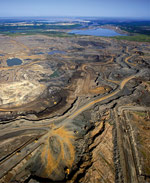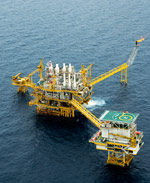- Oil and gas from the sea
- > Offshore gas and oil production began more than a century ago. With many shallow-water fields already exhausted, these natural resources are now being extracted at ever greater depths. Production rates are higher than ever, while oil pollution is decreasing. However, this is largely due to the stringent regulations applicable to shipping: the explosion at the Deepwater Horizon oil rig clearly demonstrated that safety is a long-neglected issue in the oil industry.

Less marine oil pollution – despite growing energy demand
The international debate about climate change and carbon dioxide emissions notwithstanding, our energy consumption is increasing year by year. Global energy demand has doubled since the early 1970s and is likely to grow by a further one-third by 2035. The world’s insatiable energy hunger is mainly caused by population growth in Asia and ongoing industrialization in the emerging economies. Even with the expansion of renewables, experts predict that fossil fuels – coal, oil and gas – will continue to provide most of our energy. Whereas there is enough coal and gas to meet demand well beyond the end of this century, oil production is likely to decrease by 2050. Many coal and gas deposits onshore and in shallow marine waters are almost completely depleted. Tertiary recovery techniques, which involve pumping hot water or polymers into the reservoirs to extract the remaining oil, are now being employed in an attempt to increase yields. The industry is also moving into ever deeper waters. Although deep-water gas and oil extraction is around four times more expensive than shallow-water production, rising oil prices are making it more economically viable. Oil is now being extracted at depths of more than 2900 metres below the surface of the sea, and the water depth record for subsea gas production is currently around 2700 metres. Various types of platform are used by the oil and gas industry. Drilling operations generally involve the deployment of specialized drilling rigs, which are then replaced with production rigs once drilling is complete. In many regions today, production systems are also being installed directly on the sea floor. These subsea systems involve the use of compressors, pumps and power supply modules in a single seabed facility. As the blowout at the Deepwater Horizon drilling rig in the Gulf of Mexico in 2010 showed, oil production at great depths presents particular challenges. In the case of this particular blowout, it took a full three months to cap the flow of oil from the seabed. Oil disasters on this scale are a tragedy. Thankfully, however, such large-scale incidents, or indeed tanker disasters, now account for just 10 per cent of marine oil pollution in an average year. A much greater problem is the ongoing marine pollution that travels along less obvious pathways – in other words, the chronic contamination of the marine environment from numerous smaller sources, such as oil discharges from shipping as a result of illegal tank cleaning or carelessness during loading. But as the European countries have demonstrated, pollution incidents of this kind can be reduced with intensive aerial surveillance of coastal waters. The good news is that marine oil pollution has decreased worldwide in recent decades. International conventions and agreements on the protection of the marine environment have made a very significant contribution here, for example by introducing a mandatory requirement for double hull tankers. Surveillance of seaways has also improved dramatically, thanks to better radar technology and vessel identification systems. And many countries have adopted detailed contingency plans for an organized and internationally coordinated oil spill response. Despite this positive trend, the amount of oil entering the oceans every year – around one million tonnes at present – is still far too high, with oil continuing to contaminate countless marine habitats and organisms.


